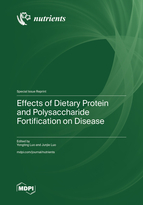Effects of Dietary Protein and Polysaccharide Fortification on Disease
A special issue of Nutrients (ISSN 2072-6643). This special issue belongs to the section "Proteins and Amino Acids".
Deadline for manuscript submissions: closed (15 May 2023) | Viewed by 66192
Special Issue Editors
Interests: cardiovascular disease; atherosclerosis; vascular remodeling; cancer; mitochondria; cell signaling; cell metabolism
Special Issues, Collections and Topics in MDPI journals
Interests: metabolic diseases; cancer; aging; molecular nutrition; mitochondrial metabolism; mitochondrial metal ions; mtDNA mutation/editing; ROS; ferroptosis
Special Issues, Collections and Topics in MDPI journals
Special Issue Information
Dear Colleagues,
The observation that healthy diets are beneficial for human being has boosted interest in the concept of “food as medicine” and “preventive treatment”. Proteins and polysaccharides are kinds of versatile natural macromolecules that are ubiquitous in the biosphere, whose biological effects are either structure-, protective- or storage-related. These bioactive nutrients modulate transcription factors involved in inflammation and oxidative stress, mitigate mitochondrial dysfunction, act as senolytics and impact the epigenome by altering metabolism. As a consequent, tailored diet fortified with protein and polysaccharide has been developed to ameliorate a wide array of diseases, such as metabolic disease, cardiovascular disease, intestinal disease, and neurodegenerative disease.
This Special Issue of Nutrients, entitled “Effects of dietary protein and polysaccharide fortification on disease” aims to be an interdisciplinary platform that covers all beneficial aspects related to proteins or polysaccharides. We invite well-designed research articles, reviews, as well as meta-analysis studies that addressing the development, modulation and characterization of new dietary strategy with bioactive protein and polysaccharide fortification for the treatment of various disorders and their complications.
Dr. Yongting Luo
Dr. Junjie Luo
Guest Editors
Manuscript Submission Information
Manuscripts should be submitted online at www.mdpi.com by registering and logging in to this website. Once you are registered, click here to go to the submission form. Manuscripts can be submitted until the deadline. All submissions that pass pre-check are peer-reviewed. Accepted papers will be published continuously in the journal (as soon as accepted) and will be listed together on the special issue website. Research articles, review articles as well as short communications are invited. For planned papers, a title and short abstract (about 100 words) can be sent to the Editorial Office for announcement on this website.
Submitted manuscripts should not have been published previously, nor be under consideration for publication elsewhere (except conference proceedings papers). All manuscripts are thoroughly refereed through a single-blind peer-review process. A guide for authors and other relevant information for submission of manuscripts is available on the Instructions for Authors page. Nutrients is an international peer-reviewed open access semimonthly journal published by MDPI.
Please visit the Instructions for Authors page before submitting a manuscript. The Article Processing Charge (APC) for publication in this open access journal is 2900 CHF (Swiss Francs). Submitted papers should be well formatted and use good English. Authors may use MDPI's English editing service prior to publication or during author revisions.
Keywords
- polysaccharide
- protein
- protein and polysaccharide fortification
- beneficial effects
- metabolic disease
- cardiovascular disease
- intestinal disease
- neurodegenerative disease








